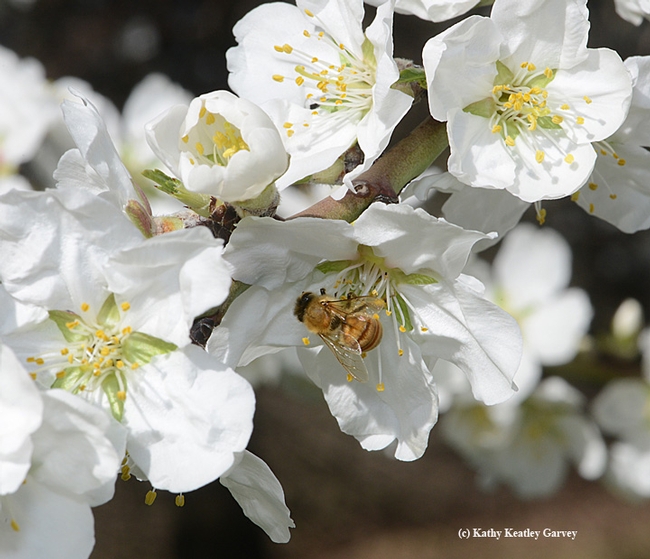
That's the soothing sound of honey bees gathering food for their colony--and in the process, pollinating almonds.
The buzz is to bees what a purr is to a cat.
On the UC Davis campus, almonds are still blooming--on Bee Biology Road and in the UC Davis Arboretum, among other sites.
But the almond pollination season that began around Valentine's Day in California is almost over. By mid-March, it's fini.
The solo almond tree that bloomed in early January in the Benicia State Recreation Area is already leafed out. It's the perfect hot spot: sun-warmed asphalt, southern exposure and no neighbors to shade it.
Meanwhile, the Almond Board of California (ABC) newsroom is buzzing, too.
"Through research we know that almond pollen is very nutritious for honey bees," said Bob Curtis, director of agricultural affairs at ABC said in a news release. "Research also shows that bee hives increase in strength during the time they spend pollinating almonds. This allows many beekeepers to then split their hives and grow their apiaries, giving the beekeepers and their bees a good foundation for the upcoming year. After their stay in the almond orchards, bees move on to pollinate more than 90 other crops in our state and elsewhere in the nation."
California now has 1 million acres of almonds, and each acre requires two bee hives for pollination. And how many almond growers are there in the state? More than 6,000, according to ABC.
"While good soil, climate, and other factors are crucial, without honey bees to pollinate our trees each spring, there would be no almonds," said Curtis in the news release. "And without almond blossoms, the bees would lose their first source of natural pollen each year. It's a win-win relationship."
Back in 2014, almond growers, beekeepers, bee breeders and scientists got together and hammered out the "Honey Bee Best Management Practices (BMPs) for California Almonds."
Extension apiculturist (now emeritus) Eric Mussen of the UC Davis Department of Entomology and Nematology, participated in that major endeavor.
In the news release, Mussen said that the almond industry is "responding strongly on honey bee health and, in particular, pesticide use and considerations during bloom. He said that the BMPs "go far beyond the almond orchard, providing important insights for all crops when it comes to promoting honey bee health."
"Since their release, the BMPs have been shared at over 70 industry meetings with more than 7,000 copies distributed to almond farmers and beekeepers alike," according to the ABC news release. "The strong, favorable response to the BMPs marks another milestone in the effort to protect honey bee health and preserve the mutually beneficial relationship between honey bees and almonds."
Without bees, no almonds, so the relationship between the almond growers and the beekeepers must continue to be nurtured, cultivated and strengthened.
You can access the ABC's Honey Bee BMPs at Almonds.com/BeeBMPs. And for more information about the pollination partnership between honey bees and almonds, access "The Buzz on Bees + Almonds."
Meanwhile, listen to the bees buzz, a sure sign of winter's demise and spring's promise.
Attached Images:


